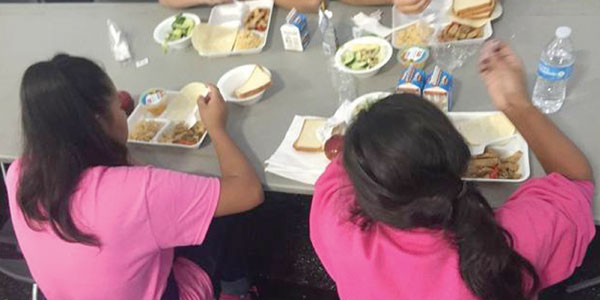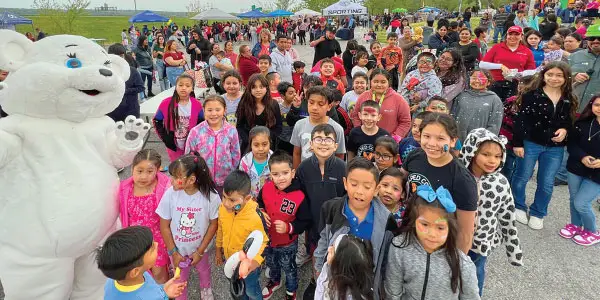
By Jorge Ramos
HOMESTEAD, Fla. — When you first look around, everything seems normal: hundreds of kids, some in classrooms, others playing soccer, others in the dining hall or in their dorm rooms.
Soon, though, it becomes clear that something is wrong. None of the youngsters are holding cellphones or tablets. And they all have stern or sad expressions on their faces, as if they’re holding something back. Eventually, you realize what the problem is: These children aren’t allowed to leave. They’re in detention.
I recently visited the Homestead Job Corps center in southern Florida, a detention facility serving roughly 1,600 children between the ages of 13 and 17, most of them from Guatemala, Honduras or El Salvador. At the time of my visit, 3 out of 4 were boys. (You can watch a video of my visit here.)
The Homestead children endured shocking experiences to reach the United States. They fled violence, gangs and extreme poverty, and made the journey across Mexico (which, according to many Central Americans, is the worst part of the trip north) unaccompanied. They then crossed the U.S. border illegally or surrendered themselves to immigration authorities at a legal port of entry.
All of the children at Homestead were wearing new clothes — they looked just like regular teenagers anywhere else in the world. Unfortunately, I couldn’t talk to any of them. I was only allowed to visit Homestead Job Corps on the condition that I did not interact with any of the minors housed there (a measure to protect them, the authorities said). Each child spends an average of 58 days at the detention facility, which is run by a private company that, according to one of the managers, receives around $750 per child per day, from the U.S. government.
Children at Homestead are only allowed to make two 10-minute phone calls each week: One to their home country and the other, usually, to relatives in the United States hoping to sponsor them out of federal custody. They learn the telephone numbers by heart; one of the few times I saw them smile was during those phone calls. After a long and cumbersome legal process, the children can be released to the care of their sponsors, who can be a parent, an uncle, an aunt or any other family member. If a child has no relatives in the United States, his or her friends can serve as sponsors. If all else fails, the child may end up in an orphanage or foster home.
Something horrible happens, however, if these kids turn 18 while still at Homestead. They don’t get a cake or a party; instead, they get handcuffed and released to the custody of officers from U.S. Immigration and Customs Enforcement, who take them to a prison or an adult detention center. Once there, they await deportation proceedings.
There are over 100 detention centers for child immigrants spread across 17 U.S. states, and many of them are operating at near full capacity or planning to expand. Why? Because the number of unaccompanied minors crossing the border is on the rise.
In 2012, 13,625 children were held in facilities administered by the U.S. Department of Health and Human Services. That number spiked in 2018, when 49,100 minors were detained. And 2019 may well break all records.
Why is the U.S. government holding children in detention facilities for months? Aren’t there better ways to deal with child immigrants who cross the border alone? Is it really necessary to cuff a boy’s hands and feet just because he turns 18?
Our laws direct the government to oversee, through the Department of Health and Human Services, the custody of every child under 18 entering the country illegally, if that child is not accompanied by a parent or “legal guardian.” A manager at Homestead told me during my visit that this is “a great government program.” Texas Rep. Joaquin Castro, however, has said that these kinds of facilities are part of a “morally bankrupt system.”
The facade of normalcy at Homestead comes crumbling down when you realize that the children there are being held against their will. I was told that only two of them managed to escape in the past year.
The most powerful country in the world should be doing much more for the region’s most vulnerable children. A Hollywood film would portray them as heroes overcoming adversity; here, they are nothing more than prisoners.
_________________________________________________________________________
Niños Detenidos
HOMESTEAD, Fla. — Todo parece muy normal. Son cientos de niños en salones de clase y jugando fútbol. Otros están en el comedor o en los dormitorios. Algunos más en la enfermería o hablando con sus supervisores. Pero de pronto te das cuenta de que hay algo raro. Los jóvenes no tienen celulares ni tabletas. Existe una cierta seriedad o tristeza en todos ellos, como si se guardaran sus emociones. Hasta que caes en cuenta en lo más básico: Estos niños no se pueden ir de aquí. Están detenidos.
Cuando visité el Centro de Homestead Job Corp en el sur de la Florida había 1.621 niños entre los 13 y los 17 años de edad. Casi todos venían de Guatemala, Honduras y El Salvador. Tres de cada 4 son varones.
Es increíble todo lo que han pasado para llegar hasta aquí. Vienen huyendo de extrema pobreza, de violencia y de las pandillas. Cruzaron solos México (que muchos centroamericanos dicen es la peor parte de todo su trayecto). Y entraron ilegalmente a Estados Unidos, o se entregaron a las autoridades migratorias en los puertos legales de entrada.
No pude hablar con ninguno de ellos. Para visitar este Centro como condición que no hubiera ningún tipo de contacto. Es, dicen las autoridades, para protegerlos. Todos iban vestidos con ropa nueva — se parecían a adolescentes en cualquier parte del mundo. Suelen estar aquí, en promedio, 58 días. Y como este es un centro operado por una empresa privada, el gobierno de Estados Unidos paga, según me informó una de las coordinadoras del lugar, aproximadamente $750 por niño por día. Hagan las sumas.
Los niños sólo pueden hacer dos llamadas telefónicas de 10 minutos a la semana: una a su país de origen y la otra, generalmente, a los familiares o conocidos a donde se quieren ir a vivir en Estados Unidos.
Los niños se memorizan los números telefónicos y durante esas llamadas fue de las pocas veces que los vi sonreír. Tras un largo y complicado proceso legal, los niños son entregados a su padre, madre, tío, tía u otro familiar. Si no hay nadie de su familia en Estados Unidos, pueden quedarse con amigos y conocidos. Y si todo falla, terminan en orfanatos o con familias adoptivas.
Pero algo horrible ocurre cuando estos niños cumplen 18 años de edad. En lugar un pastel y una fiesta, el mismo día de su cumpleaños son esposados y llevados por agentes de migración (ICE) a una prisión o a un Centro detención para adultos. Una vez ahí se enfrentan a procesos de deportación. Así es su primer “happy birthday” en Estados Unidos.
Estados Unidos tiene más de 100 Centros de detención para menores de edad en 17 estados y muchos de ellos están al máximo de su capacidad o expandiéndose. ¿La razón? Cada vez hay más niños solos cruzando la frontera.
En el año fiscal 2012 hubo 13.625 niños en instalaciones a cargo del Departamento de Salud y Servicios Humanos (HHS). Pero eso se disparó en el 2018 cuando 49.100 menores de edad estuvieron detenidos. Y el 2019 puede romper todos los récords.
¿Por qué Estados Unidos está en el negocio de detener a niños durante meses? ¿No hay otra manera de tratar a niños inmigrantes que llegan solos al país? ¿De verdad es necesario esposar de piés y manos a un muchacho por el simple hecho de cumplir 18 años de edad?
La ley indica que el gobierno, a través del HHS, debe ejercer la custodia de todo menor de 18 años, que entre ilegalmente al país y que no tenga un padre o “guardián legal” que lo cuide. Una coordinadora de la instalación en Homestead me dijo durante la visita que este es “un gran programa del gobierno”. Sin embargo, el congresista Joaquín Castro ha dicho que estos programas forman parte de un “sistema moralmente en bancarrota”.
La aparente normalidad en un Centro como estos desaparece cuando te das cuenta de que los niños están obligados a quedarse aquí. Sólo dos lograron escaparse en el último año, me dijeron en el Centro.
El país más poderoso del mundo podría hacer mucho más por los niños más vulnerables del continente. En una película de Hollywood serían héroes escapando de la adversidad; aquí son detenidos.
Posdata. Aquí está el video de mi visita: bit.ly/2VGOoD5.









